
Every thirty-three seconds, cardiovascular disease takes a life in the U.S., making it the leading cause of death for men and women.
Yet, the risk factors, symptoms, and diagnosis can present in dramatically different ways.
By recognizing these differences, both men and women can receive appropriate, effective treatment that could save a life.
Let’s explore the different ways that heart disease affects men and women.
Look for these shared risk factors:
While both men and women share common risk factors for heart disease, such as:
● High blood pressure
● High cholesterol
● Use of tobacco
● Irregular heart rhythms
● Congenital heart defects
Look for these unique risk factors:
● Men are more likely to develop heart disease earlier than that of women, influenced by:
○ Hormonal Differences: Men have lower levels of estrogen and progesterone, hormones that help maintain blood vessel health, which may contribute to an increased risk of heart disease in men.
○ Abdominal Obesity: Men are more prone to accumulating visceral fat around the abdomen, which is linked to increased inflammation and a higher risk of heart disease.
○ Stress and Anger: High levels of stress and anger have been associated with an increased risk of heart attacks. Often, higher levels of testosterone in men are correlated to greater levels of stress and anger.
● Women face unique risks, including:
○ Hormonal changes during menopause: Decreased levels of estrogen after menopause may increase the likelihood of heart disease in older women.
○ Pregnancy-related complications: Disorders such as preeclampsia and gestational diabetes elevate the risk for heart disease.
○ Microvascular disease: Women are more susceptible to microvascular disease, which affects the smaller arteries, and may not be detected by traditional diagnostic methods.
Be aware of the different symptoms The symptoms of heart disease often present differently in men versus women. By understanding the differences, we can increase the likelihood of proper diagnosis and treatment.
● Men typically experience the classic symptoms such as chest pain or discomfort, which may radiate through the shoulder or arm.
● Women often experience symptoms that do not commonly represent those associated with heart disease, including:
○ Back or jaw pain
○ Nausea or vomiting
○ Shortness of breath
○ Indigestion
○ Extreme fatigue
These subtler symptoms can occur with or without chest pain, making them easier to overlook. The long-standing misconception that heart disease primarily affects men has led to underdiagnosisunder diagnosis in women, highlighting the need for greater awareness among both patients and healthcare professionals
Challenges in Diagnosis and Treatment
Because men and women experience heart disease differently, diagnostic and treatment strategies must be tailored to fit the unique needs of each gender.
Diagnostic Approach for Men
● Because men typically experience blockages in major blood vessels compared to women, heart disease is more likely to be properly diagnosed by more standard diagnostic tests
● Coronary angiography—a standard test that detects large arterial obstructions—is typically effective in diagnosing heart disease in men, but may not be as effective for women who experience microvascular disease.
Diagnostic Approach for Women
● Women are more prone to microvascular disease, which affects the smaller arteries and may not be visible on traditional angiography.
● To diagnose heart disease in women accurately, stress tests with imaging, coronary flow reserve measurements, and MRI scans may be needed to detect abnormalities in small blood vessels.
Treatment Disparities
● Studies show that women with heart disease are less likely than men to be prescribed preventive treatments such as aspirin and statins.
● This disparity may contribute to higher rates of heart attack complications and mortality among women.
Differing Responses to Treatment
● Women often have different responses to heart disease medications, which can influence the effectiveness and side effects of certain treatments.
● Personalized treatment plans that consider hormonal influences, medication metabolism, and heart structure differences are essential for improving outcomes.
Raising awareness among healthcare providers about these gender differences is crucial for improving early detection and treatment. By implementing unique diagnostic tools, preventive strategies, and personalized treatments, we can work toward reducing disparities and improving survival rates for both men and women.
Why It Matters
Heart disease can happen to anyone and it can be life-altering when it strikes. However, by understanding how heart disease affects men and women differently, we can better prevent and treat it, giving everyone a better chance at a healthy life. To learn more about how to respond in times of emergency check out the information provided below!
At Starting Hearts, we can provide you with specific training that can make a life-saving.
difference.
Contact us for more information: info@startinghearts.org.
Cassidy Layne is a pre-nursing student, EMT-trainee, and healthcare writer based in Texas.
________________________________________
